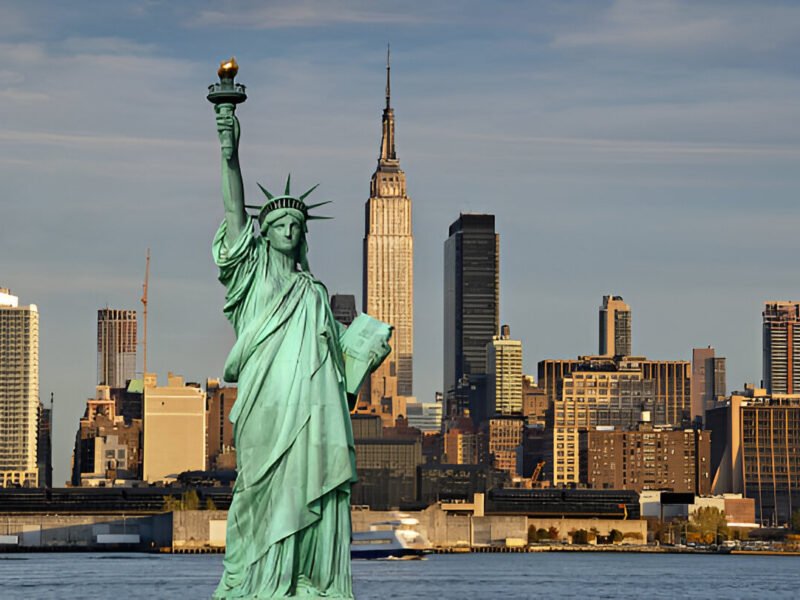Certain U.S. cities consistently attract the most employer-sponsored immigrants thanks to strong job growth, established support systems, and pathways to permanent residence. Below, you’ll find a closer look at where sponsored workers find opportunities and community in 2025, highlighting strengths, salary ranges, leading employers, and local support.
New York, NY: Global Opportunity Meets Community Strength
New York City stays at the top for sponsored jobs due to its sheer size, diverse industries, and long tradition as an immigrant gateway. In 2025, NYC remains a powerhouse for H-1B visa jobs and green card sponsorships.
- Stats: The metro area saw over 30,000 H-1B filings in 2024, second only to the Bay Area, and thousands of employment-based green card applications.
- Major Employers: JPMorgan Chase, Mount Sinai Health System, Citi, Deloitte, and Google anchor the city’s sponsorship activity, offering jobs across finance, tech, consulting, and healthcare.
- Top Industries:
- Finance (Wall Street investment banks, fintech firms)
- Technology (Google, Meta, Amazon tech offices)
- Healthcare (major hospital systems, research centers)
- Median Base Salary: H-1B filings reveal a typical range from $85,000 to $140,000, higher for senior roles or in finance/tech.
- Cost of Living: Median rent for a one-bedroom apartment in Manhattan runs $3,500–$4,200. Daily expenses (commuting, food, childcare) add up quickly, making budgeting essential even with strong wages.
- Diversity & Support Networks: New York boasts thousands of ethnic associations, religious organizations, legal service nonprofits, and immigrant support centers. Major neighborhoods offer a ready-made community for new arrivals.
Seattle, WA: Where Tech Talent Thrives
Seattle remains a top draw for immigrants looking for sponsored tech roles. The local economy thrives on innovation and steady job creation.
- Job Numbers: Roughly 13,000 H-1B petitions were filed from Seattle-area employers in 2024. Green card filings continue to climb, thanks to retention by leading companies.
- Key Employers: Amazon and Microsoft lead the nation in sponsorship, each sponsoring several thousand workers per year. Other anchors include Boeing (aerospace engineering), Expedia, and newer tech start-ups.
- Dominant Sectors:
- Technology (software development, cloud computing, AI roles)
- Aerospace (Boeing and its suppliers)
- Life sciences and biotech
- Average Compensation: Software engineers and tech workers see median wages between $130,000 and $190,000, with benefits and stock options common at larger employers.
- Living Considerations: Seattle’s rents are lower than New York or San Francisco but remain a challenge, with the median rent for a one-bedroom near $2,400. The city’s mild climate, transit, and access to nature set it apart.
- Community Support: The International Rescue Committee, OneAmerica, and a host of city agencies help with everything from English classes to legal advice. Established Asian, East African, and European communities add to the fabric.
San Francisco, CA & Silicon Valley: The Epicenter of Tech Sponsorship
The Bay Area leads all U.S. metros in both volume and variety of sponsored high-skill immigrant jobs, especially in tech.
- Tech-Centric Opportunities: More than 35,000 H-1B petitions and over 7,000 green card filings came from area employers in 2024, mainly in software, hardware, and internet services.
- Key Companies: Google, Apple, Meta, Salesforce, Oracle, and dozens of fast-growing start-ups drive demand for IT, data science, engineering, and design roles.
- Industry Demand: High for software developers, machine learning engineers, cybersecurity experts, fintech professionals, and biotech researchers.
- Salary Data: Median base salaries for H-1B tech roles range from $145,000 to over $200,000, the nation’s highest. Stock grants and performance bonuses add to total compensation.
- Affordability Issues: The average rent for a one-bedroom in San Francisco tops $2,900, and the broader Bay Area is nearly as expensive. Living south (San Jose, Fremont) offers some relief, and new arrivals sometimes share housing to offset costs.
- Nearby Options: Cities like Oakland, Fremont, and Hayward provide slightly lower rents and growing immigrant populations, plus easier commutes to Silicon Valley’s job centers.
Austin, TX: Sunbelt Growth & Welcoming Culture
Austin has rapidly climbed the list of top destinations for sponsored workers, especially in tech and creative fields.
- Rise in Sponsored Jobs: Austin employers filed more than 6,000 H-1B petitions last year, a number that’s risen every cycle since 2020. Local tech growth fuels demand for global talent.
- Core Industries:
- Software and IT (Dell, Apple’s second headquarters, Oracle, many start-ups)
- Creative sectors (digital media, music, video game production)
- Healthcare and engineering
- Salary Info: Average base salaries for sponsored roles fall in the $95,000–$135,000 range in technology and rise for more experienced positions.
- Cost Advantages: A one-bedroom apartment averages $1,500–$1,800 per month, making Austin far more affordable than coastal hubs. No state income tax stretches paychecks for newcomers.
- Community Appeal: Austin’s welcoming climate, vibrant food scene, and strong local immigrant groups (Asian, African, and Latino) make settling in easier. Groups like Casa Marianella and Asian Family Support Services offer practical local help.
Emerging Cities: Naples & Sarasota, FL; Ann Arbor, MI; Madison, WI
Mid-sized cities now play a bigger role in sponsored job opportunities, especially in specialized fields. Here’s where the trends point for 2025.
- Naples & Sarasota, FL: Healthcare and real estate are booming. Local hospital systems and elder care providers frequently sponsor nurses, therapists, and administrative staff. These cities offer a median rent under $2,000 and a slower pace of life.
- Ann Arbor, MI: The University of Michigan drives education and research-sponsored green cards. The city is friendly to international students and research professionals. Median salaries for STEM roles sit near $80,000, with rents around $1,400.
- Madison, WI: Strong in healthcare, education, and biotechnology. Major hospitals and the university sponsor a steady stream of immigrants. Living costs are among the lowest in top 50 metro areas, and tight-knit neighborhoods offer a sense of belonging.
- Benefits of Mid-Sized Cities:
- Lower living costs mean salaries go further.
- Stable job markets in healthcare and education.
- Smaller communities make integration easier.
- Growing support networks (international student groups, cultural organizations).
Each of these cities reflects shifting patterns where opportunity, affordability, and welcome intersect for new immigrants in 2025.
Industry and Employer Trends for Sponsored Immigrant Workers
The demand for immigrant talent in the U.S. labor market continues to climb as companies and cities look for ways to stay competitive in 2025. Employers are not only filling critical gaps—they are also driving innovation and boosting productivity across multiple sectors. By looking at real visa and green card filing data, we can see clear trends in which industries and employers are most active, and where future growth lies for sponsored immigrant workers.
Leading Industries: Who Is Sponsoring Most in 2025?
Some industries stand out for their constant need for skilled foreign talent. These sectors actively sponsor the highest number of H-1B, green card, and seasonal work visas:
- Technology: Software engineers, data scientists, cybersecurity specialists, and system architects remain at the top of the sponsorship charts. Firms like Amazon, Microsoft, Google, Meta, Tata Consultancy Services, and Infosys each sponsor thousands of employment-based visas per year. These jobs nearly always come with six-figure salaries in both established hubs (Silicon Valley, Seattle) and emerging tech cities.
- Healthcare: Registered nurses, physical therapists, physicians, pharmacists, and lab technicians fill urgent shortages. Large health networks and medical centers, especially in underserved regions, consistently sponsor EB-2 and H-1B visas. Hospitals, clinics, and elder care facilities in cities like New York, Houston, Naples, and Sarasota remain aggressive recruiters.
- Engineering: Civil, electrical, and mechanical engineering roles are in demand for expanding infrastructure and real estate. Major global consultancies, construction giants, and companies in renewable energy look outside the U.S. to fill these specialized roles.
- Finance and Professional Services: Big financial institutions and accounting firms frequently sponsor high-skill visas. JPMorgan Chase, Deloitte, EY, Citi, and Goldman Sachs use H-1B and L-1 visas to keep up with the global shift toward advanced analytics, fintech, and regulatory compliance.
- Agriculture and Construction: These sectors lean on the H-2A and H-2B programs for seasonal and vocational workers. Employers like NCGA and Fresh Harvest Inc. lead agriculture sponsorship while construction staffing firms hire through seasonal visa channels.
These top industries signal that the most consistent opportunities for sponsored immigrants are in fields facing the sharpest labor shortages or the fastest technological changes.
Top U.S. Employers: The Biggest Sponsors in the Job Market
A handful of employers set the pace when it comes to sponsorship activity. Here’s a look at some of the most active sponsors according to public filings from 2024 and early 2025:
- Amazon: Over 10,000 new H-1B visas filed in the last fiscal year, with average salaries of $140,000–$170,000.
- Google and Meta (Facebook): Both topping several thousand sponsorships yearly, hiring mainly for engineering, research, and business analysis.
- Microsoft: A major force in software and cloud recruitment, sponsoring across its U.S. offices.
- Deloitte and EY: Big accounting and consulting firms hire international MBAs, finance experts, and IT specialists.
- Tata Consultancy Services and Infosys: Leaders in tech consulting, providing IT and engineering talent for U.S. clients.
- Major Health Systems: Mount Sinai (NY), Cleveland Clinic (OH), and Texas Medical Center (TX) stand out for sponsoring medical professionals.
- Construction and Seasonal Labor Firms: Progressive Solutions LLC, Genuine Builders Inc., and numerous regional contractors working with the Department of Labor to staff time-sensitive projects.
Some emerging mid-sized metro employers are also making their mark, especially in healthcare, education, and biotech. These companies are increasingly important in cities facing population growth and aging demographics.
Visa and Green Card Filing Trends
Visa sponsorship data helps reveal which fields are both stable and fastest-growing for immigrants. A few key points:
- Tech and Healthcare Dominate: In 2024, over 60% of new H-1B filings came from tech and health companies.
- Engineering and Professional Services: Regular, predictable green card filings reflect true long-term hiring, not just seasonal needs.
- Specialized Talent: Jobs that are hardest to fill domestically, like AI research, specialty nursing, and bilingual client service, are especially likely to be sponsored.
- Salary Transparency: Median base salaries for sponsored tech roles now move above $120,000 in most major metros, while healthcare positions average $75,000–$130,000 depending on specialization.
These ongoing trends show that jobs that are hard to automate, require deep expertise, or face domestic shortages remain the best bet for green card sponsorship.
Future Job Growth and Sector Demand Projections
Labor data and employer outlooks suggest that sponsored immigrant workers will keep playing a critical role in American job growth through 2052. Key projections include:
- Healthcare: The U.S. will need millions of new healthcare workers as the Baby Boomer generation retires. Demand for immigrant nurses, doctors, and technicians will only rise—for both direct patient care and behind-the-scenes lab work.
- Technology: Positions in software, cybersecurity, machine learning, and cloud services are projected to grow much faster than average. The tech sector relies on immigration to keep pace with startups, innovation, and global competition.
- Infrastructure and Heavy Equipment: Skilled tradespeople, including welders, machinists, and electrical specialists, face steep shortages. Expanded infrastructure spending and aging cities mean new jobs in these areas, with immigrant workers filling many placements due to domestic shortfalls.
- Manufacturing and Advanced Processes: Despite automation, roles in advanced manufacturing and R&D continue to need specialized foreign talent, especially as U.S. companies reshore production and develop new tech.
- Education and Research: Universities and research hospitals will stay strong sponsors, especially for STEM (science, technology, engineering, mathematics) professors and researchers.
According to recent research, immigrant workers contributed 88% of all labor force growth since 2019. As the U.S. population ages and domestic workforce growth slows, sponsored immigrant workers will drive not just short-term staffing but also long-term economic health.
What Workers Can Expect: Skills, Timing, and Policy
To stand out, sponsored job seekers should focus on:
- Advanced or Specialized Skills: Fields like tech, healthcare, engineering, and hard-to-staff trades.
- Credentials and Certifications: U.S. licensing or industry certification helps move applications forward.
- Timing: Major employers often submit visa applications during the first quarter of the year or in sync with new project cycles. Seasonal workers should watch for openings early in the calendar year.
Policy changes and industry trends may lead to new types of sponsorship, especially for vocational workers and emerging roles. Workers with a track record of adaptability, unique skills, or cross-industry experience will have the clearest path to sponsorship in the years ahead.
The trends are clear: for anyone seeking a long-term future in the U.S. through a sponsored job, opportunities remain strongest in technology, healthcare, engineering, and the skilled trades. Staying informed, upskilling, and targeting the right employers makes all the difference.
Conclusion
Choosing the right U.S. city for a sponsored job shapes both your first steps and your future in the country. The best cities for immigrants stand out not just because of the number of available positions, but also for their strong industries, high pay, and support networks that help newcomers settle and grow. Cities like New York, San Francisco, and Seattle offer top wages and career connections, while Austin and Madison provide balance with lower costs and stable local economies.
When considering your move, match your career goals with cities that offer growth in your field. Look at employer trends and weigh salary with cost of living. These details help you make a choice that supports your ambitions and daily life.
Let this data be your guide as you plan your next steps. If you have experience with sponsored jobs or questions about a specific city, add your insights in the comments below. Your journey helps others looking for their own best place to start. Thank you for reading and sharing your thoughts.








